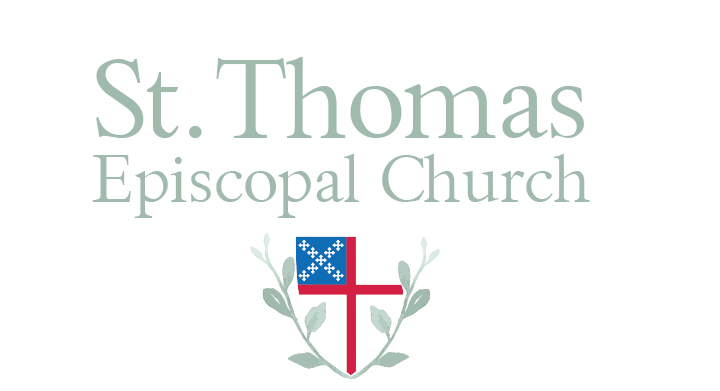Our Roots
St. Thomas Episcopal Church is a small church with a long history. When one talks about St. Thomas, the word “oldest” keeps appearing: It is the oldest operating church in Hunterdon County; among the oldest Episcopal church buildings in New Jersey; and the 12th oldest congregation in the state.
This welcoming community was started by the Apostle to New Jersey, the Rev. John Talbot, in 1723, when he was already 78. Having founded St. Mary’s Burlington on the Delaware River in 1703, Rev. Talbot nurtured several churches in West Jersey, including St. Andrew’s Ringoes and St. Michael’s Trenton, along with St. Thomas’. Initially the parish met in a wooden structure across the road from our current site, and we believe the substantial beam in our Sanctuary comes from that structure. Rev. Talbot made several visits and was followed by a series of missionaries sent from Great Britain by the Society for the Propagation of the Gospel in Foreign Parts to serve Alexandria, Ringoes and sometimes Ewing.
The wooden structure fell into disrepair by the 1750’s, and the community was fortunate that members of one of the wealthiest families in New Jersey, the Stevens, took an interest in building our current sanctuary with its magnificent windows. Building started in the mid 1760’s, and a lottery raised the final funds for its completion. The glass may well have come from the clandestine glass factory started by Casper Wistar in Salem County NJ, which also produced scientific glassware for Benjamin Franklin.
While the Revolution meant there were no longer clerics sent from Great Britain, many missionaries stayed on in the new country, and St. Thomas’ was a founding member of the Diocese of New Jersey in 1785. St. Thomas’ was served by our first American-born cleric, the Rev. Dr. Henry Waddell, who was based at the much larger St. Michael’s Trenton. The diocese had more churches than clergy, but after the death of Rev. Waddell in 1811 it provided roving missionaries for many years. St. Thomas’ sent a delegate to the 1815 State Convention that elected New Jersey’s first Bishop – Rt. Rev. John Croes. St. Thomas’ shared clerics with St. Andrew’s Ringoes for many years, and one, Rev. William Croes Crane, made efforts to establish churches in Flemington (ultimately successful) and in Clinton (ultimately unsuccessful). He installed the stone proclaiming the construction of our wall in 1839.
Rt. Rev. Croes and succeeding bishops made yearly visits to St. Thomas, but the Parish gradually faded into obscurity. Fortunately, a major restoration was funded by Hon. Frederick A. Potts, a wealthy coal merchant, railroad operator, insurance magnate and Republican politician. When this reconstruction was completed in 1875, the church was reopened by the newly installed 4th Bishop of New Jersey, the Rt. Rev. John Scarborough. The pedal-powered Needham Reed Organ in our gallery dates from this restoration.
Despite Hon. Potts efforts, the church was still on the periphery of the Diocese, and while there were usually yearly summer services, the main stewards of the little chapel seem to have been the St. Thomas’ Burial Society. These good people mowed the churchyard, and ensured the roof remained watertight. The church basically hunkered down until the middle of the 20thCentury.
More frequent worship at St. Thomas’ was restored under the guidance of Rev. Henry Charlton Beck, who had been a newspaperman in Camden, and then a publicist for the Diocese of New Jersey. Installed as Rector of Calvary Flemington, he started regular summer services at St. Thomas’ in the 1950’s and a community of worshippers gradually developed. Subsequent clergy at Calvary Flemington maintained this nurture, and St. Thomas’ finally gained its own part-time cleric in the form of the Rev. Canon Reinhart B. Gutmann in 1970. Canon Gutmann had a fulltime career in Social Welfare Services in New York City and moved to Rhode Island to become national director of Foster Parents Plan, Inc. in 1976.
He was followed (1976-1982) by the Rev. Richard Townley, jointly vicar at St. Thomas’ and St. Andrew’s Lambertville. In 1982 this joint appointment was rescinded, and St. Thomas’ was blessed with the appointment of Rev. Ann C. Holt, the first woman to be put in charge of an Episcopal Church in New Jersey. The church grew under her leadership, eventually graduating from a Mission Church to a Regular Parish in 1996. The Parish Hall was built as an addition to the historic structure in 1994. Rev. Holt retired in 1991 to be followed by the Rev. Andrea Baldyga (2001-2005) who had previously been a cardiac surgeon, and then the Rev. Canon Carol Horton (2006-2021), who had previously been in the Diocese of Bethlehem, PA. The church thrived under the leadership of these three ladies, but then came Covid, and the church moved to virtual services and a much smaller congregation.
St. Thomas’ was blessed with wonderful visiting clergy after Canon Horton’s retirement, and the Parish returned to slow but steady growth. Nevertheless the shrunken congregations and shrunken finances of St. Thomas’ and Calvary Flemington have the two congregations renewing their historic ties with an affiliation, and share the ministry of the Rev. Kyle Cuperwich who joined us in 2023.
More details of the history of this beautiful little church can be found in ST. THOMAS’ ALEXANDRIA, BY ROGER PRINCE


